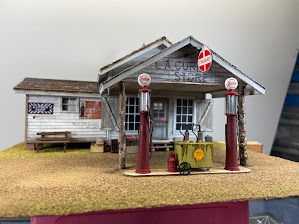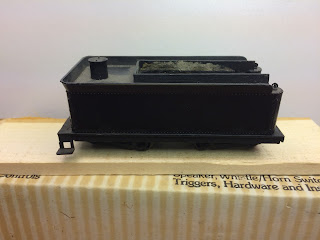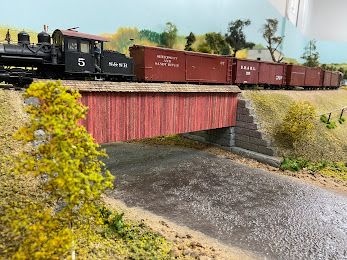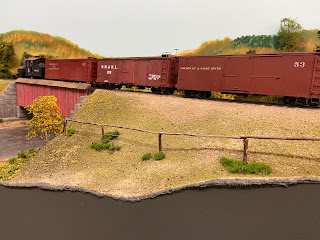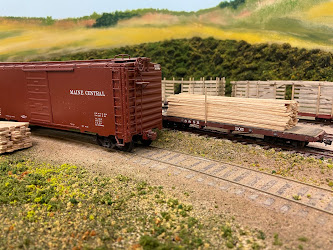Been doing a lot of work on the railway over the last month. I'm in the layout room (garage) most days working on the layout itself ......scenery.......making adjustments to the track work gauge wise etc.
Also building additional rolling stock from some older Sandy River Car Shop kits I've had tucked away.
I'm running out of wheel sets, as the ones I'm using are/were made by "Railboxx" and they seem to have dissapeared. They had short axel HO wheel sets which fit the Grandt Line 2' gauge trucks perfectly. (I'm modeling the SR&RL using 30" gauge). Going to have to hunt up a new supplier or start swapping out my old kit bashed Bachmann rolling stock (mostly Boxcars) as I build up some new ones. I had gone to the trouble of narrowing the Bmann cars to 6' widths in line with SR box car widths. They served well enough, but they were only 24' cars instead of the normal 28' prototype cars. The other BIG issue was that the doors on the Bmann cars slide to the left side of the car......I believe they were based on a prototype narrow gauge rr car, but they were a bit of an oddity in practice.

When I started modeling Maine 2' I knew I would be "proto-freelancing" and called the railroad the Sheepscot and Sandy River Rwy. It was a good choice because I was interested in both the WW&F and the SR&RL's. My previous layout had more of a Wisscasset look to it.
Since the move to Charleston SC, I've designed the layout to follow the Sandy River from Farmington to Strong to Phillips on the mainline and will build a second level featuring the branch to Kingfield, Carrabassett and Bigelow (the old Franklin & Megantic RR).
The dilemma of what to call the railway continues because there are only 2 Bmann engines (inside and outside frame Forneys) that are close to prototype. I will need more than SR&RL's #8 and #9 to run the railroad so compromise is in order! I have two BLI D&RGW C-16's that I'm in the process of converting to resemble what "could have been" motive power wise had the SR continued past 1935. I left one a 2-8-0 but lowered the cab down to SR 2' height. I had to cut the plastic boiler shell to allow the cab to slide down.
I cut the tender down a bit (I believe it was a tender that came from a slightly larger C-19 class) but it still looks way to tall in my eyes.)
The second "connie" was a much more involved rebuild.........I eliminated the the 3rd blind driver and replaced it with the 4th flanged driver. That gave me a good start on making it a Prairie type. Problem was all the SR prairies were built with outside frames. "Close but no cigar"......but maybe a somewhat "usable" cigar!
I did a lot of cutting and bashing on this one, cutting down the height of the domes and moving them to new locations on the boiler; cutting new running boards where needed and removing all the cast on piping in favor of brass piping to the appliances. I moved the air pump and added an additional air tank to try to resemble engines #23 and #24 which came later from Baldwin. The cab was lowered as much as I could get it and I replaced the larger/wider C-16 cab with a Forney cab which I had extended lengthwise.
On to the tender.....with just a little refitting I was able to remove the C-19 tender shell and replaced it with a Bachmann shell from their Outside frame 2-8-0.
Added a better looking coal load, a crew in the cab and a couple of toolboxes and called it "done".


